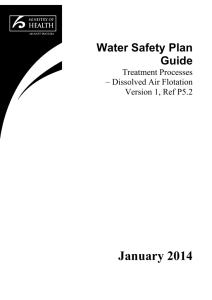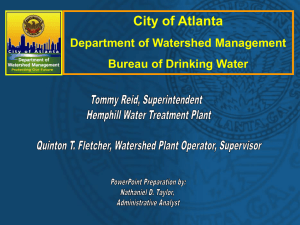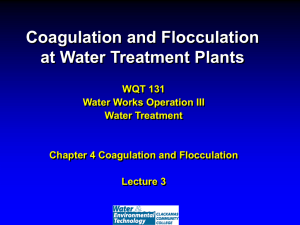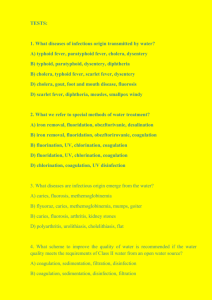Conventional Coagulation/Flocculation/Sedimentation
advertisement
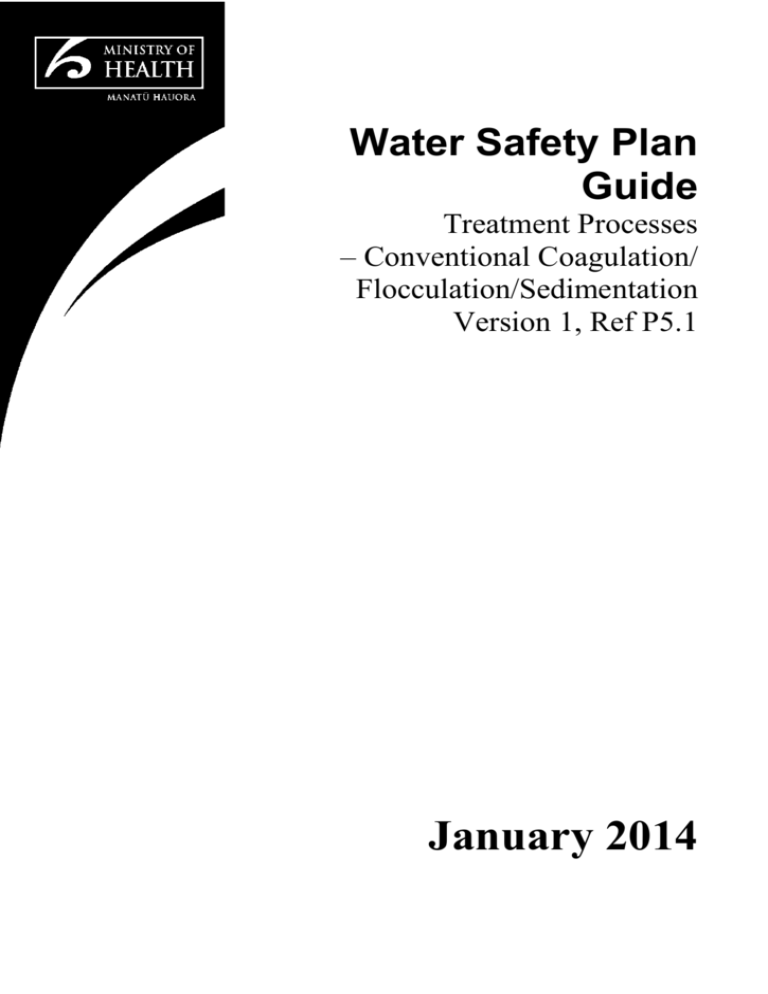
Water Safety Plan Guide Treatment Processes – Conventional Coagulation/ Flocculation/Sedimentation Version 1, Ref P5.1 January 2014 Citation: Ministry of Health. 2014. Water Safety Plan Guide: Treatment Processes – Conventional Coagulation/Flocculation/Sedimentation, Version 1, ref p5.1. Wellington: Ministry of Health. Published in January 2014 by the Ministry of Health PO Box 5013, Wellington, New Zealand ISBN: 978-0-478-42724-0 (print) ISBN: 978-0-478-42725-7 (online) Previously published in 2001 as Public Health Risk Management Plan Guide: Treatment Processes – Conventional Coagulation/Flocculation/Sedimentation, Version 1, ref p5.1. This publication’s title and any reference within the text to ‘public health risk management plan’ was changed in January 2014 to reflect the December 2013 legislation change of the term ‘public health risk management plan’ to ‘water safety plan’. No other changes have been made to this document. This document is available at www.health.govt.nz This work is licensed under the Creative Commons Attribution 4.0 International licence. In essence, you are free to: share ie, copy and redistribute the material in any medium or format; adapt ie, remix, transform and build upon the material. You must give appropriate credit, provide a link to the licence and indicate if changes were made. Contents Introduction 1 Risk Summary 2 Risk Information Table 3 Contingency Plans 8 Water Safety Plan Performance Assessment 9 Ref P5.1 Water Safety Plan Guide: Treatment Processes – Version 1, January 2014 Conventional Coagulation/Flocculation/Sedimentation iii Introduction This Guide deals with the processes of coagulation, flocculation and sedimentation which together are used to remove particles (including some large germs, eg, Giardia and Cryptosporidium) and natural organic matter from drinking-water. If an event occurs during the coagulation/flocculation/sedimentation process (ie, the process doesn’t work properly), the following could happen: If particles are not removed, sickness can come from larger germs not being removed If natural organic matter is not removed, it reacts with the disinfectant and can cause sickness from germs not being killed, and from disinfection by-products If chemicals used in the coagulation/flocculation process are carried into the distribution system, they can cause sickness. The use of coagulant, polymer and pH-adjusting chemicals can present risks to the health of treatment plant operators. These are acknowledged, but are not discussed further as such risks are the subject of health and safety in employment legislation. The coagulation/flocculation/sedimentation process and the risks associated with it cannot be viewed in isolation. How well the process works affects: filtration which comes after it (see P6 series of Guides); flocs not removed will more rapidly clog the filters, or pass through them if the flocs are very small disinfection (see P7 series of Guides); organic matter in the water will use up more disinfectant leaving less for disinfection. Several factors influence how effective the coagulation/flocculation/sedimentation process is: the quality of the source water; waters with little turbidity or of variable quality make good coagulation difficult, and the composition of the organic matter also affects the process (see Guide S1.1 and the P1 series of Guides) coagulant and flocculant type and their dose control; poor dose control is likely to cause poor floc formation pH and alkalinity control; if the pH is too low or too high flocs will dissolve, and good removal of organic matter requires a low pH during coagulation and a higher pH during flocculation contact times between chemicals and water; there must be enough mixing time to allow flocs to form hydraulics at each stage; the coagulant must be added with rapid mixing, but mixing must be slowed during flocculation to avoid breaking up the flocs. If the whole process is going to work as well as possible, care must be taken in the operation of chemical dosing and control systems and the design and operation of the mixing chambers and sedimentation tank. Ref P5.1 Water Safety Plan Guide: Treatment Processes – Version 1, January 2014 Conventional Coagulation/Flocculation/Sedimentation 1 Risk Summary The event creating the greatest risk involved in the coagulation/flocculation/ sedimentation of drinking-water is poor removal of particles (see P5.1.1). The most important preventive measure is to make sure chemical dosing can be controlled to cope with changing raw water quality and quantity (see P5.1.1.2). (References in parentheses are to the Risk Information Table.) 2 Water Safety Plan Guide: Treatment Processes – Conventional Coagulation/Flocculation/Sedimentation Ref P5.1 Version 1, January 2014 Risk Information Table Reliable information about water quality is essential for the proper management of a water supply. Knowledgeable and skilled staff are also essential for minimising the public health risks associated with water supplies. Please read the staff training (Guide G1) and the monitoring guides (Guide G2). While we haven’t pointed out every detail of how these documents are linked with the present document, the links are many and are important. Abbreviations: MAV – Maximum acceptable value – see Drinking-Water Standards for New Zealand:2000; NTU – nephelometric turbidity units Causes Preventive measures Checking preventive measures Corrective action Signs that action is needed What to check Event: PARTICLES NOT REMOVED Possible hazards: Germs not removed (particularly Giardia and Cryptosporidium). Level of risk: High1 P5.1.1.1 Dosing malfunction. Routine maintenance schedule for the dosing system – pumps and lines, probes and meters, electronics (see Guide P10). Maintenance log. Maintenance log not signed off. Prior to coagulation: Prior to coagulation, the following are not optimised for the conditions: Alarm systems to indicate when turbidity after the filter is too high, and when coagulation pH is outside the target range. Routine monitoring of coagulant residuals in filtered water. – – – pH jar test Post-filter: – – – – – – zeta potential. turbidity colour aluminium, or iron, or polymer. Start monitoring programme. pH jar test zeta potential. Post filter: – – – – 1 Identify cause of fault and rectify. turbidity is more than 0.2 NTU colour is more than 10 TCU aluminium residual is more than 0.15 mg/L elevated residual levels of other coagulants. The consequences of the event, and therefore the level of risk, will be influenced by the quality of the source water and the effectiveness of treatment processes after coagulation, flocculation and sedimentation, ie, filtration and disinfection. Ref P5.1 Water Safety Plan Guide: Treatment Processes – Version 1, January 2014 Conventional Coagulation/Flocculation/Sedimentation 3 Causes Preventive measures Checking preventive measures Corrective action Signs that action is needed What to check Event: PARTICLES NOT REMOVED cont’d P5.1.1.2 Dosing rates set incorrectly or inappropriately. P5.1.1.3 Determine and document the relationships between source water quality and coagulant type and demand, flocculant type and demand, and optimum pH. Ensure that chemical dosing is able to respond quickly to changing source water quality and quantity, ie. appropriate choice of manual, flow proportional or automatic dose control (eg, streaming current detector, colour, turbidity). Plant flow rate. Electricity supply. Stand-by generator. Power failure. P5.1.1.4 Chemical supply exhausted. 4 Place an alarm on the chemical supply tanks to indicate when they are close to running out. Maintain records of chemical use to provide a guide to the length of time each chemical supply is likely to last. Maintain a reserve supply adequate to cover the time before resupply. No jar test records. No dosing control based on source water quality. Elevated turbidity, colour and residual coagulant in filtered water. Chemical dosing flows. Visual inspection for floc stability. Source and post-filter: – – – – – Determine relationships and document. Install appropriate dosing control equipment. Adjust dose rates. Obtain a generator or alternative power source. Refuel generator if necessary. Install or repair alarm system. turbidity colour pH alkalinity coagulant and/or flocculant. Supply levels of coagulant, flocculant and pH-adjusting chemical. Usage rates of coagulant, flocculant and pH-adjusting chemical. Poor continuity of power supply. Chemical supply exhausted. Elevated turbidity and colour in filtered water. Water Safety Plan Guide: Treatment Processes – Conventional Coagulation/Flocculation/Sedimentation Urgent order chemicals. Start keeping record of chemical use. Ref P5.1 Version 1, January 2014 Causes Preventive measures Checking preventive measures Corrective action Signs that action is needed What to check Event: PARTICLES NOT REMOVED cont’d P5.1.1.5 Incorrect chemical used. Make sure chemicals are supplied to the correct storage tanks. Clearly label supply tanks; ensure operator on site when chemicals delivered. – – – – – – P5.1.1.6 Chemicals of poor quality. No delivery records. Elevated turbidity and colour in filtered water. Staff absent during chemical delivery. colour No jar test records. pH No dosing control based on source water quality. In source water: – Chemical delivery records. turbidity alkalinity coagulant and/or flocculant Check strength of chemicals supplied and calculate dilutions required for dosing. Check chemicals supplied for presence of health-significant chemical contaminants. Empty, clean and refill storage tank. Introduce and/or ensure delivery procedure. Require chemical supplier to ensure that operator is present when chemicals are delivered. Trial several coagulants and flocculants. Consider preoxidation (beware of disinfection by-product formation) (see Guide P4.3). Determine relationships for the most appropriate coagulant and flocculant and means of pH control. Check calculations. zeta potential jar test. Carry out jar tests and zeta potential measurements to determine the best coagulants and flocculants and their optimum doses every time raw water characteristics change. Supplier’s certificate of analysis. Coagulant, flocculant and pH-adjusting chemicals. Dilution records. Supplier’s certificate of analysis. Chemicals of possible health significance following dilution. No supplier’s certificate. Elevated turbidity and colour in filtered water. Calculation checks not signed off. No supplier’s certificate for chemical composition. Chemicals of potential health significance exceed 50% of their MAVs in the treated water. Ensure quality of treated water is safe. If not, dump treated water. Adjust dilutions and/or dose rates as necessary. Change supplier. Ref P5.1 Water Safety Plan Guide: Treatment Processes – Version 1, January 2014 Conventional Coagulation/Flocculation/Sedimentation 5 Causes Preventive measures Checking preventive measures Corrective action Signs that action is needed What to check Event: PARTICLES NOT REMOVED cont’d P5.1.1.7 Inadequate mixing of chemicals. P5.1.1.8 Check mixing times are adequate for effective coagulation and flocculation over the range of flow rates through the plant, and that carry over to the filter is not excessive. Determine the range of flow rates that will allow flow to settle. Insufficient contact time for floc formation. P5.1.1.9 Ineffective settling of floc. P5.1.1.10 Floc removal mechanism malfunction. 6 Check that mixing of coagulant, flocculant and pH-adjusting chemicals is adequate over the range of flow rates through the plant. Coagulant, flocculant and pH-adjusting chemicals. Plant flow rate. Turbidity. Colour. Visual inspection of floc stability. Elevated turbidity and colour in filtered water. Turbidity of water leaving the clarifier in the range of 2-5 NTU. Post filter: – – Turbidity of clarified water. – Frequency of filter backwash. – turbidity is more than 0.2 NTU colour is more than 10 TCU aluminium residual is more than 0.15 mg/L elevated residual levels of other coagulants. (See P5.1.1.7.) (See P5.1.1.7.) Review treatment plant hydraulics to provide improved contact time during coagulation and flocculation. Plant flow rate. (See P5.1.1.7.) Review treatment plant hydraulics to allow adequate settling of floc. Identify cause of fault and repair. Observe and record conditions that bring about buoyant flocs and ‘boiling’. Where controllable, avoid these conditions. Where uncontrollable, be prepared for increased filter loading. Visual inspection of floc stability. Maintenance log. Frequent filter backwash. Frequency of filter backwash. Elevated turbidity and colour in filtered water. Routine maintenance schedule. Review treatment plant hydraulics to provide improved mixing of chemicals. Turbidity of clarified water. Frequency of filter backwash. Water Safety Plan Guide: Treatment Processes – Conventional Coagulation/Flocculation/Sedimentation Ref P5.1 Version 1, January 2014 Causes Preventive measures Checking preventive measures Corrective action Signs that action is needed What to check Event: PARTICLES NOT REMOVED cont’d P5.1.1.11 Ineffective floc removal. Ensure design and control of floc removal system are appropriate for the capacity and design of the clarifier and its sludge loading. Ensure there is sufficient capacity in the sludge disposal system to handle peak load. Visual inspection of floc stability. Turbidity of clarified water. Frequency of filter backwash. Frequent filter backwash. Elevated turbidity and colour in filtered water. Odour and increased chlorine demand from anaerobic conditions. Review design and control system. Increase capacity of sludge disposal system. Event: NATURAL ORGANIC MATTER NOT REMOVED Possible hazards: Germs; disinfection by-products (trihalomethanes, haloacetic acids, chloral hydrate (chlorine), chlorite (chlorine dioxide), bromate, bromoform, formaldehyde (ozone)). Level of risk: Moderate1 P5.1.2 The causes, preventive measures, etc., for this event are the same as those given for event P5.1.1. See P5.1.1.1–P5.1.1.11. Event: TREATMENT CHEMICALS CARRIED INTO DISTRIBUTION SYSTEM Possible hazards: Health significant chemicals (acrylamide, epichlorohydrin) Level of risk: Low2 P5.1.3 The causes, preventive measures, etc., for this event are the same as those given for event P5.1.1. See P5.1.1.1–P5.1.1.11. 1 The consequences of the event, and therefore the level of risk, will be influenced by the quality of the source water and the effectiveness of treatment processes after coagulation, flocculation and sedimentation, ie, filtration and disinfection. 2 Some low turbidity waters are difficult to treat with conventional coagulants. Ref P5.1 Water Safety Plan Guide: Treatment Processes – Version 1, January 2014 Conventional Coagulation/Flocculation/Sedimentation 7 Contingency Plans If an event happens despite preventive and corrective actions you have taken, you may need to consult with the Medical Officer of Health to assess how serious a problem is. Event – Turbidity higher than maximum acceptable level Indicators: A turbidity of less than 0.2 NTU cannot be maintained in the water leaving the treatment plant. Required actions: Follow the actions given in Figure 3.4 of DWSNZ:2000. Identify the reason for the failure and rectify. Record the reason for the failure and the steps taken to rectify. Modify the water safety plan if necessary. Responsibility: Manager designated responsible for water supply. Event – Excessive levels of treatment chemicals carried into the distribution system Indicators: Required actions: Responsibility: 8 Consumer complaints of discoloration, poor taste, sensation, odour. Excessive chemical concentrations measured in the water leaving the treatment plant or in the distribution system. Notification of error by operator or chemical delivery contractor. Follow Section 4.4 of DWSNZ:2000. Identify the reason for the failure and rectify. Monitor chemical until it reaches acceptable limits. Record the reason for the failure and the steps taken to rectify. Modify the water safety plan if necessary. Manager designated responsible for water supply. Water Safety Plan Guide: Treatment Processes – Conventional Coagulation/Flocculation/Sedimentation Ref P5.1 Version 1, January 2014 Water Safety Plan Performance Assessment To make sure that your supply’s water safety plan (formerly known as a Public Health Risk Management Plan, PHRMP) is working properly, periodic checks are needed. The overview document outlines what needs to be done. The following table provides the detailed information for checking this particular supply element. What to measure or observe: Turbidity, colour and aluminium in filtered water. E. coli (faecal indicator), coliforms. Follow the protocols set out in DWSNZ:2000. Note that the presence of faecal indicators may be influenced by factors other than the adequacy of the coagulation/flocculation/ sedimentation process. How often: What to do with the results: Responsibility: For the monitoring frequencies for turbidity and E. coli measurements see DWSNZ:2000 Section 3.3.2. Monitoring for colour and aluminium will likely be part of regular process control, but as a minimum should be immediately following a change in source water quality that requires a change to manual chemical dosing. Results need to be recorded to meet legislative requirements or to allow water safety plan performance assessment. The WINZ database is good for this. The collected data need to be periodically reviewed to see whether problems with this supply element are developing. This should be done as frequently as the manager responsible considers necessary to minimise risk to public health arising from this supply element. Should this review show any unusual incidents, indicate that proper procedures are not being carried out, highlight poor laboratory results or indicate that poor water quality is reaching customers, then review the procedures for managing coagulation/flocculation/sedimentation. Evaluate the monitoring results, and any actions taken as the result of having to implement a contingency plan, to see if the water safety plan needs modification – eg, preventive measures are up to date; the contingency plan steps are still adequate; and changes to the treatment processes are recognised in the plan. Manager designated responsible for the water supply. Ref P5.1 Water Safety Plan Guide: Treatment Processes – Version 1, January 2014 Conventional Coagulation/Flocculation/Sedimentation 9

